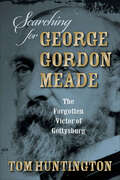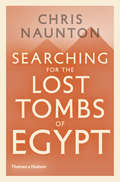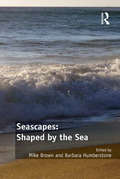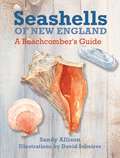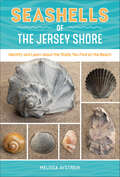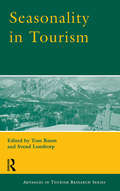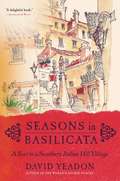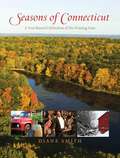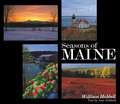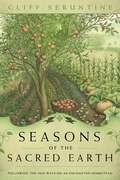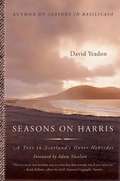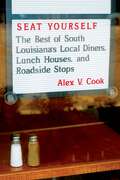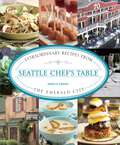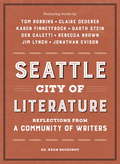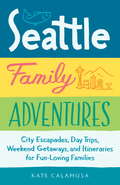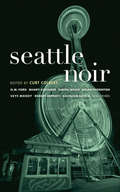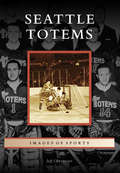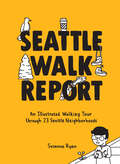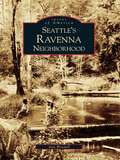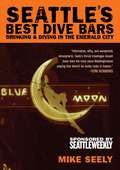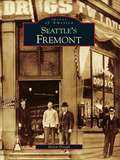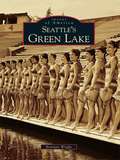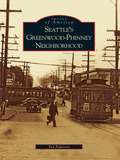- Table View
- List View
Searching for George Gordon Meade: The Forgotten Victor of Gettysburg
by Tom HuntingtonA historian chronicles the life of the Union Civil War general while recounting his own unusual journey during his investigation into the past. Who was George Gordon Meade? He should be remembered as one of the Civil War&’s most important generals. Instead, history has pushed him aside. The hot-tempered Meade received command of the Union&’s dysfunctional Army of the Potomac only three days before he defeated Robert E. Lee&’s Confederates at Gettysburg. After that, Meade watched his reputation decline, thanks in part to the escape of Lee&’s army, hostility from politicians and the press, the machinations of Gen. Daniel Sickles, and the rise of Ulysses S. Grant. &“I suppose after a while,&” Meade once grumbled, &“it will be discovered I was not at Gettysburg at all.&” The Rodney Dangerfield of Civil War generals, Meade gets no respect—and author Tom Huntington wanted to find out why. In Searching for George Gordon Meade, he tells the story of the general&’s life and his participation in the Civil War&’s great engagements, from George McClellan&’s Richmond Campaign to Appomattox. Huntington also provides accounts of his own investigations of Meade&’s legacy. Along the way he hikes across battlefields, recites the names of fallen soldiers at a candlelit ceremony at Gettysburg, drinks a champagne toast at Meade&’s grave on New Year&’s Eve, and visits a severed leg, a buried arm, and a horse&’s head. The result is a quirky and compelling mash-up of history, biography, travel, and journalism that casts new light on an overlooked figure from the past. Praise for Searching for George Gordon Meade&“Unique and irresistible.&” —Harold Holzer, chairman of Lincoln Bicentennial Foundation&“Huntington&’s wry, boisterous biography-within-a-travel journal . . . strives to remake the reputation of Meade and offers a compelling new way to approach biography.&” —John G. Shelby, Meade: The Price of Command, 1863–1865 &“It&’s the rare reader who will not enjoy accompanying Huntington on his search for Meade.&” —America&’s Civil War "A refreshingly readable and well-researched book. . . . Searching for George Gordon Meade should be required reading for all those interested in Civil War history.&” —Civil War News
Searching for the Lost Tombs of Egypt
by Chris NauntonAn exciting archeological exploration of ancient Egypt that examines the potential for discovering the remaining “lost” tombs of the pharaohs. Tombs, mummies, and funerary items make up a significant portion of the archeological remains that survive ancient Egypt and have come to define the popular perception of Egyptology. Despite the many sensational discoveries in the last century, such as the tomb of Tutankhamun, the tombs of some of the most famous individuals in the ancient world—Imhotep, Nefertiti, Alexander the Great, and Cleopatra—have not yet been found. Archeologist Chris Naunton examines the famous pharaohs, their achievements, the bling they might have been buried with, the circumstances in which they were buried, and why those circumstances may have prevented archeologists from finding these tombs. In Searching for the Lost Tombs of Egypt, Naunton sheds light on the lives of these ancient Egyptians and makes an exciting case for the potential discovery of these lost tombs.
Seascapes: Shaped By The Sea
by Mike Brown Barbara HumberstoneDespite the fact that the sea covers 70 per cent of the Earth’s surface, and is integral to the workings of the world, it has been largely neglected or perceived as marginal in modern consciousness. This edited collection disrupts notions of the sea as ’other’, as foreign and featureless, through specific, situated accounts which highlight the centrality of the sea for the individuals concerned. Bringing together academics who combine scholarly expertise with lived experiences on, in and with the sea, it examines humans’ relationships with the sea. Through the use of auto-ethnographic accounting, the contributors reflect on how the sea has shaped their sense of identity, belonging and connection. They examine what it is to be engaged with the sea, and narrate their lived, sentient, corporeal experiences. The sea is a cultural seascape just as it is physical reality. The sea shapes us and we, in turn, attempt to ’shape it’ as we construct various versions of it that reflect our on-going and mutable relationship with it. The use of embodied accounts, as a way of conveying lived-experiences, and the integration of relevant theoretical frames for understanding the broader cultural implications provide new opportunities to understand seascapes.
Seashells of New England: A Beachcomber's Guide
by Sandy AllisonIdentify just about any seashell found on New England beaches, from southern Connecticut to northern Maine. Beautiful illustrations and straightforward descriptive text help readers identify 70 different seashells, and learn a little bit about them--most likely anything a reader wants to identify will be included, without a lot of "extra" species. Expert information offered in an appealing format for beachcombers, amateur naturalists, and anyone else who loves the beach. Includes advice on how and where to find great shells.
Seashells of the Jersey Shore: Identify and Learn about the Shells You Find on the Beach
by Melissa AvstreihIdeal for beachgoers who want to know more about the shells they find, this well-organized book will help readers identify more than 35 of the most common seashells found on New Jersey's beaches. The well-researched guide offers information about the animals that once lived in the shells, including where they lived, what they ate, and even how they may have died. The handy guide's features include • color photographs of real shells; • fun facts about the shells and the animals that lived in them; • a section on nonshell treasures from the sea; • a user guide to help make identification simple; and • a lightweight, portable size that is perfect to tuck into a beach bag. From Sea Bright to Cape May, Seashells of the Jersey Shore will help curious beachcombers of all ages to identify and learn about the shells they find down the shore.
Seasonality in Tourism (Advances In Tourism Research Ser.)
by Tom Baum Svend LundtropSeasonal variation in demand is a reality for most tourism destinations. This work provides a balanced overview of the evidence and issues relating to tourism seasonality using European, North American and Pacific Rim cases and research evidence.
Seasons in Basilicata
by David YeadonAward-winning travel writer and illustrator, David Yeadon embarks with his wife, Anne on an exploration of the "lost word" of Basilicata, in the arch of Italy's boot. What is intended as a brief sojourn turns into an intriguing residency in the ancient hill village of Aliano, where Carlo Levi, author of the world-renowned memoir Christ Stopped at Eboli, was imprisoned by Mussolini for anti-Fascist activities. As the Yeadons become immersed in Aliano's rich tapestry of people, traditions, and festivals, reveling in the rituals and rhythms of the grape and olive harvests, the culinary delights, and other peculiarities of place, they discover that much of the pagan strangeness that Carlo Levi and other notable authors revealed still lurks beneath the beguiling surface of Basilicata.
Seasons of Connecticut: A Year-Round Celebration Of The Nutmeg State
by Diane SmithSeasons of Connecticut is a beautiful, four color celebration of the Nutmeg state by a veteran television and radio reporter who has told the stories of the people and places of Connectiut for twenty years. The sixty stories included in this book will make people feel good about living in Connecticut, and make others want to visit, revealing the beauty and the personality of the state throughout the year.
Seasons of Maine
by William Hubbell Jean HubbellBill Hubbell writes in his preface that entering Maine is not like crossing into other states: "A few miles after having passed the border, a subtle awareness sneaks in. The woods seem deeper, the sky higher, the air fresher, the spaces wider, the distances longer. Maine is an expansive place--for the spirit, for the body, for the soul."Here, in more than a hundred and forty wonderful color images, lifetime professional photographer Hubbell has captured the very essence of his home state in all four seasons. This is not an "art" book but a tribute to the diverse places and ever-changing character that make Maine special. Accomplishing this goal involved an exhaustive crisscrossing of the state, requiring fourteen months, thirty-two thousand miles, and six hundred and forty rolls of film.The result is a feast for the eyes. Anyone who has visited or lived in Maine will cherish these photographs and marvel at the skill of the man who took them. Here are Portland's Old Port, resplendent in its Christmas finery; Penobscot Bay, plied by graceful windjammers; the Machias Blueberry Festival and its hands-off pie-eating contest; isolated Eastern Egg Rock and its colorful puffins; Baxter State Park, crowned by majestic Katahdin; and much, much more.Whether you delight in sights that you've never had a chance to see, or relive the memory of places that instantly became favorites, Bill Hubbell's vision of Maine is sure to please for years to come.
Seasons of the Sacred Earth: Following the Old Ways on an Enchanted Homestead
by Cliff Seruntine"We are just one little family on a small homestead deep in a wild place. What we can do is small, but perhaps through this book we can impart the wisdom we have discovered. It is just this: spirit and enchantment and reality are bound together in a green world full of wonders."Living Green with the Spirits of the LandIn 2007, the Seruntine family relocated to a secluded Nova Scotia homestead. They made it a point to live gently upon the land by growing and raising their own food, living in balance with the surrounding forest, and honoring Nature's spirits. In return, the land and the spirits looked after them. Seasons of the Sacred Earth follows life deep in their woodland hollow through a magical year. It is a marvelous journey into a place where gardens grow by love and magic, where children romp through enchanted forests, where mystery beckons by light of fireflies. And living close to Nature, they discover an ancient truth: the magical and the mystical are never farther than Earth and Sky.
Seasons on Harris
by David YeadonThe Outer Hebrides of Scotland epitomize the evocative beauty and remoteness of island life. The most dramatic of all the Hebrides is Harris, a tiny island formed from the oldest rocks on earth, a breathtaking landscape of soaring mountains, wild lunarlike moors, and vast Caribbean-hued beaches. This is where local crofters weave the legendary Harris Tweed--a hardy cloth reflecting the strength, durability, and integrity of the life there. In Seasons on Harris, David Yeadon, "one of our best travel writers" (The Bloomsbury Review), captures, through elegant words and line drawings, life on Harris--the people, their folkways and humor, and their centuries-old Norse and Celtic traditions of crofting and fishing. Here Gaelic is still spoken in its purest form, music and poetry ceilidh evenings flourish in the local pubs, and Sabbath Sundays are observed with Calvinistic strictness. Yeadon's book makes us care deeply about these proud islanders, their folklore, their history, their challenges, and the imperiled future of their traditional island life and beloved tweed.
Seat Yourself: The Best of South Louisiana's Local Diners, Lunch Houses, and Roadside Stops
by Alex V. CookLouisiana can be a complicated place, but the state's good food and friendly people provide reliable pleasures. Pairing these two indisputable facts, author Alex V. Cook takes readers to the many unsung diners, quirky low-fuss restaurants, and family-run establishments that serve up the very best of true Louisiana cuisine. From a gas station with the best boudin links to a Vietnamese bakery with mouthwatering bánh mì, lesser-known culinary gems stitched across southeast Louisiana offer tasty local fare in a down-to-earth atmosphere. Setting off from the state capital of Baton Rouge and winding through the back roads of Cajun country, then turning southward to the Gulf, and finally veering onto side streets in New Orleans, Cook profiles more than thirty must-visit eateries with wit and an eye for the authentic. Along the way, a culinary landscape emerges that is markedly genuine, surprisingly diverse, and deliciously free from affectation. With indispensable venue information, personal recommendations, and entertaining anecdotes, Seat Yourself: The Best of South Louisiana's Local Diners, Lunch Houses, and Roadside Stops is a vivid, humorous, and sharply written hat tip to those Louisiana constants: amazing food and great people.
Seattle Chef's Table: Extraordinary Recipes from the Emerald City (Chef's Table)
by James FraioliCelebrating Seattle&’s best restaurants and eateries with recipes and photographsHot chefs are setting the Seattle restaurant scene ablaze. With innovative ideas and culinary surprises, the city&’s most heralded restaurants and eateries continue adding spark to an already sizzling food scene. From James Beard winners Holly Smith and Maria Hines to Chris Mills, who competed on the original Japanese Iron Chef in Tokyo, and restaurants like Volterra, which Rachael Ray named one of her &“favorite restaurants in the world,&” the Emerald City is filled with celebrity chefs, heralded restaurants, and Food Network star eateries that serve up delicious cuisine to locals and tourists. Seattle Chef&’s Table is the first cookbook to gather Seattle&’s best chefs and restaurants under one cover. Profiling signature &“at home&” recipes from almost fifty legendary dining establishments, the book is also a celebration of the growing sustainable food movement in the Pacific Northwest. With full-color photos throughout highlighting fabulous dishes, famous chefs, and Seattle landmarks, it is the ideal ode to the city&’s coveted food culture and atmosphere.
Seattle City Guide
by Nicholas HortonYou won&’t miss anything in this remarkable and trendy city with this guide in hand. Whether you&’re interested in the well-known Pike Place Market, or want to branch out to see other lesser known sights and local cultural events, Seattle CityGuide is your source for up-to-date and practical information, at your fingertips. This informative and fun-to-use compendium gives the savvy traveler guidance in a nutshell on where to go, shop, eat, and stay—those places of interest that are not to be missed, as well as lesser known spots you might not find on your own.
Seattle City of Literature (EBK)
by Ryan BoudinotThis bookish history of Seattle includes essays, history and personal stories from such literary luminaries as Frances McCue, Tom Robbins, Garth Stein, Rebecca Brown, Jonathan Evison, Tree Swenson, Jim Lynch, and Sonora Jha among many others. Timed with Seattle's bid to become the second US city to receive the UNESCO designation as a City of Literature, this deeply textured anthology pays homage to the literary riches of Seattle. Strongly grounded in place, funny, moving, and illuminating, it lends itself both to a close reading and to casual browsing, as it tells the story of books, reading, writing, and publishing in one of the nation's most literary cities.
Seattle Family Adventures: City Escapades, Day Trips, Weekend Getaways, and Itineraries for Fun-Loving Families
by Kate CalamusaGet the inside scoop on the best family-friendly outings, activities, attractions, and day trips in the greater Seattle area in one comprehensive, portable guide.The Family Adventures guides are must-haves for local parents and visitors, as well as babysitters and other family members who want to explore Portland, Seattle, and the surrounding areas with kids. These go-to guides offer comprehensive ideas and listings appropriate for a wide array of ages, from babies and toddlers to young teens. Activities range from exploring children’s museums and other hands-on creative destinations to hiking, swimming, and ziplining, as well as visiting libraries, zoos, playgrounds, and much more, including where to find the best ice cream! Bursting with relevant, reliable information and tips, as well as itineraries for one day or more, these guides will take the place of hours of tedious online research. Instead you’ll find everything you need to know in one book that you can also pop into a bag or stroller and bring along with you. Whether you unexpectedly have a couple of free hours or want to plan a weekend away, grab a Family Adventures guide and make some amazing memories with your kids!
Seattle Food Crawls: Touring the Neighborhoods One Bite & Libation at a Time (Food Crawls)
by Grubbin' SeattleThe essential guide to eating your way through the Emerald City. In Globe&’s newest approach to food by city, Seattle Food Crawls takes the reader on a fun, tasty culinary tour. Discover the hidden gems and long-standing institutions of Seattle neighborhoods. Experience more than 15 crawls, each featuring 3-8 establishments, centered on a neighborhood or theme. Each tour is the complete recipe for a great night out, the perfect tourist day, a new way to experience your own city, or simply food porn and great stories to enjoy from home.
Seattle Noir (Akashic Noir)
by Curt ColbertBrand new stories by: G. M. Ford, Skye Moody, R. Barri Flowers, Thomas P. Hopp, Patricia Harrington, Bharti Kirchner, Kathleen Alcalá, Simon Wood, Brian Thornton, Lou Kemp, Curt Colbert, Robert Lopresti, Paul S. Piper, and Stephan Magcosta.Early Seattle was a hardscrabble seaport filled with merchant sailors, longshoremen, lumberjacks, rowdy saloons, and a rough-and-tumble police force not immune to corruption and graft. By the mid-50s, the town had added Boeing to its claim to fame, but was still a mostly blue-collar burg that was infamously described as "a cultural dustbin" by the Seattle Symphony's first conductor. Present-day Seattle has become a pricey, cosmopolitan center, home to Microsoft and Starbucks. The city is famous as the birthplace of grunge music, and possesses a flourishing art, theatre, and club scene that many would have thought improbable just a few decades ago. But some things never change--crime being one of them. Seattle's evolution to high-finance and high-tech has simply provided even greater opportunity and reward to those who might be ethically, morally, or economically challenged (crooks, in other words). But most crooks are just ordinary people, not professional thieves or crime bosses--they might be your pleasant neighbor, your wife or lover, your grocer or hairdresser, your minister or banker or lifelong friend--yet even the most upright and honest of them sometimes fall to temptation.Within the stories of Seattle Noir, you will find: a wealthy couple whose marriage is filled with not-so-quiet desperation; a credit card scam that goes over-limit; femmes fatales and hommes fatales; a delicatessen owner whose case is less than kosher; a famous midget actor whose movie roles begin to shrink when he starts growing taller; an ex-cop who learns too much; a group of mystery writers whose fiction causes friction; a Native American shaman caught in a web of secrets and tribal allegiances; sex, lies, and slippery slopes . . . and a cast of characters that always want more, not less . . . unless . . .Curt Colbert is the author of the Jake Rossiter & Miss Jenkins mysteries, a series of hard-boiled, private detective novels set in 1940s Seattle. The first book, Rat City, was nominated for a Shamus Award in 2001. A Seattle native, Colbert still resides in his hometown.
Seattle Totems
by Jeff ObermeyerBefore major-league professional sports came to the Northwest, Seattle had a rich minor-league sports history. In the winter, Saturday afternoons were for college football, but the nights were for hockey. From the late 1950s through the mid-1970s, hockey could only mean one thing--the Seattle Totems. Led by Guyle Fielder, the Totems won three Western Hockey League (WHL) championships as they skated and fought against their rivals. Grab a seat and get ready to learn about Seattle's hockey history from the Seattle Metropolitans, the first American team to win the Stanley Cup, through the Totems as they battle their WHL foes and even the Russian National Team in pursuit of hockey glory.
Seattle Walk Report: An Illustrated Walking Tour through 23 Seattle Neighborhoods (Seattle Walk Report)
by Susanna Ryan Seattle Walk ReportInstagram sensation Seattle Walk Report uses her distinctive comic style and eagle eye to illustrate the charming and quirky people, places, and things that define Seattle's neighborhoods.Leveraging the growing popularity of Seattle Walk Report on Instagram, this charming book features comic book-style illustrations that celebrate the distinctive and odd people, places, and things that define Seattle's neighborhoods. The book goes deep into the urban jungle, exploring 24 popular Seattle neighborhoods, pulling out history, notable landmarks, and curiosities that make each area so distinctive. Entirely hand-drawn and lettered, Seattle Walk Report will be peppered with fun, slightly interactive elements throughout which make for an engaging armchair read, in addition to a fun way to explore the city's iconic, diverse, hipster, historic, and grand neighborhoods.
Seattle's Ravenna Neighborhood
by Ann WendellFor centuries, Native American tribes lived peacefully along the trout-filled stream in a ravine that would later become part of northeastern Seattle. In 1887, the Reverend Beck disembarked from the Seattle Lake Shore & Eastern Railroad and, in this same area, bought 300 lushly forested acres that he turned into a township and park, both called Ravenna. The town was only three and a half miles from the city center and soon boasted a flour mill and a finishing school. The park itself, with its giant trees, mineral springs, fountains, and music pavilion, soon became a major attraction and well worth the 25¢ admission. Eventually the timber was harvested and the school replaced by the university. Today the park remains a haven of serenity and the stream once again runs through it.
Seattle's Best Dive Bars
by Mike Seely"Informative, witty, and wonderfully atmospheric, Seely's thirsty travelogue should leave even the most pious Washingtonians praying that there'll be honky tonks in heaven."-Tom Robbins"Seely, managing editor of the Seattle Weekly, is a genuinely funny writer who doesn't need to get snarky to get laughs...A fair amount of Seattle's heritage resides on pages of 'Seattle's Best Dive Bars,' or at least reminders of a pre-pretense city...He's penned a neat little book. Raise your cups and do something for the town's culture."-Joel Connelly, Seattle Post-Intelligencer"It has some seriously funny moments. It also has the lowdown on an impressively large number of watering holes the likes of which I've never even heard, let alone experienced firsthand."-Jessica Voelker, Seattle Metropolitan"Is this the greatest book ever written? As a native Seattlite, and long time connoisseur of dive bars, I would have to say yes. Mike Seely, who is managing editor of the Seattle Weekly, really gets it right about these places."-Greg Barbick, Blog Critics.orgSeattle's Best Dive Bars offers opinionated reviews of one hundred of the grittiest and grungiest drinking establishments in the Emerald City. If you want to avoid the tourist traps listed in those "other" bar guides and find out where the anti-globalization, anti-Starbucks, anti-Microsoft crowd goes to get wasted, then Seattle's Best Dive Bars, like its predecessors from New York, San Francisco, and Chicago, is your guide to the delightfully filthy underside of Seattle bar life.A native Seattleite, Mike Seely is the managing editor of Seattle Weekly, for which he writes a food column called "Bottomfeeder."
Seattle's Fremont
by Helen DivjakLovingly labeled by locals as the "Center of the Universe," Fremont is one of Seattle's most eclectic and dynamic neighborhoods. Having been little more than lush primeval forest just over a century ago, the area grew to be the home of the city's blue-collar workers, a bohemian haven for local artists, and now a thriving urban mecca of bars, restaurants, hip boutiques, and art studios that cater to the worldly aware. Most recently, Fremont has become the address of hightech giants like Adobe. It continues to evolve, reflectingthe changes in industry that have contributed to Fremont's reputation as an urban area on the cutting edge.
Seattle's Green Lake
by Brittany WrightDiscovered in 1855, Green Lake has been an essential feature within Seattle's distinctive juxtaposition of landscape architecture and urban expansion, providing recreation and community focus for the last 150 years. Named after the persistent algae bloom that still occurs, the lake is a valuable natural landmark at the center of a neighborhood in transition, and its past is threaded with tenacious organizations and ambitious individuals. From its first homesteader, Erhart "Green Lake John" Saifried, to the vision of the Olmsted brothers, from Guy Phinney's menagerie to the triumph and tragedy of Helene Madison, from ice-skating to the Aqua Follies, this broad collection of vintage images illustrates a bygone era and provides a unique perspective on community values and ecological struggle.
Seattle's Greenwood-Phinney Neighborhood
by Ted PedersenThe beauty of Seattle's Greenwood lies in its contrasts. It is an old-fangled neighborhood with a trendy edge, where coffee shops and espresso bars mix with caf©s, shops, and galleries patronized by antique hounds. The locals dub it "Seattle's hidden treasure." Just south, Phinney occupies a high ridge that rises from the western shore of Green Lake. The neighborhood owes its name to Guy Phinney, a wealthy immigrant from Nova Scotia who developed the private estate that became Woodland Park. Together these neighborhoods have forged a common bond, illustrated by the formation of the Greenwood-Phinney Chamber of Commerce. The area hosts a world-class zoo and is home to the only Tibetan Buddhist monastery in the world outside of Tibet.
